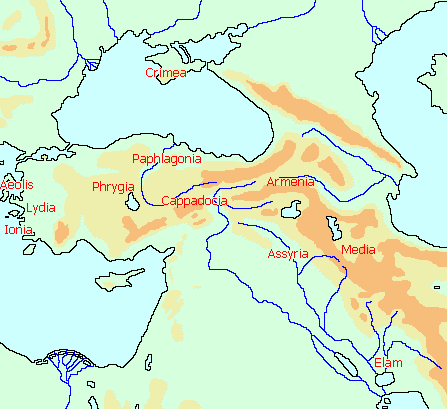Cimmerians
Q192730Cimmerians: nomadic tribe, living in Asia Minor in the seventh century BCE.

The Cimmerians are known from several Assyrian texts, which call them Ga-mir or Gi-mir-a-a. In the Assyrian language, the last name means something like "people traveling back and forth" and seems to be the less adequate of the two renderings of the Cimmerians' Indo-European name, but it describes their way of life excellently, because they were nomads. The Cimmerians were closely related and are archaeologically almost identical to the Scythians, who may have expelled them from their home country.
Originally, the Cimmerians may have lived in southern Ukraine, where the Crimea is, according to some scholars, still called after the Cimmerians. Archaeologists have identified them with the Novocerkassk culture on the grass plains between the river Prut and the Lower Don (c.900-c.650 BCE). Cimmerian men were buried with bows, sword, and spear. Everything suggests that they fought as mounted archers. Their most precious possessions were their cows, and we must imagine them as roaming across the plains with their cattle.
In the eighth century, many Cimmerians moved to the southeast, to the region north of the Caucasus. Here, they threatened the kingdom of Urartu (an old name for Armenia). The Urartian king Rusa decided upon a preventive attack, but was defeated (c.720). Almost immediately, the Cimmerians invaded Urartu and looted the country as far south as Lake Urmia.
This caused panic in Phrygia, a kingdom in western Turkey. In 710/709, a king who is, in our Assyrian sources, called Mit-ta-a (= Midas?), was forced to ask for help from the Assyrian king Sargon II. However, this did not prevent the Cimmerian invasion. In 696/695, Midas committed suicide after he had lost a battle. This was the end of Phrygia, but a new kingdom arose from the ashes: Lydia. Probably, Cimmerians settled on the Phrygian plain, which was perfectly suited to their cavalry.

During the next generation, they are mentioned several times in Assyria. In 679, their leader Teušpa and his men were besieged at a town called Hubušnu. Later, they could be found near Ellipi, Media and Elam in the extreme south. The Assyrians needed much time to restore order. At the same time, another band of Cimmerians was operating to the west of Lake Van in Urartu.
This group of Cimmerians seems to have moved to Cappadocia in the west, from where they attacked the new kingdom Lydia (c.665). They were repelled by king Gyges, but twenty years later, they were back and in 644, they defeated the Lydians and looted their capital Sardes. Gyges was killed by the Cimmerian leader Lygdamis (Dugdammê).
During the next decade, the Cimmerians raided the Greek towns in Aeolia and Ionia, looted Paphlagonia, and captured Sinope. After 640, Lygdamis attacked Assyria twice, but was defeated. Another defeat was inflicted upon them by the Lydian king Alyattes (c.600-560), after which the Cimmerians disappear from history.
There are Cimmerian finds in Bulgaria, but it is unclear whether the makers arrived directly from the Crimea, arrived from Lydia, or belong to a local civilization resembling the Novocerkassk culture mentioned at the beginning of this article.